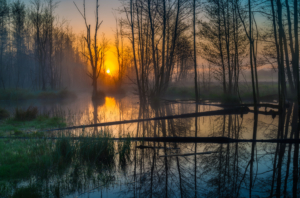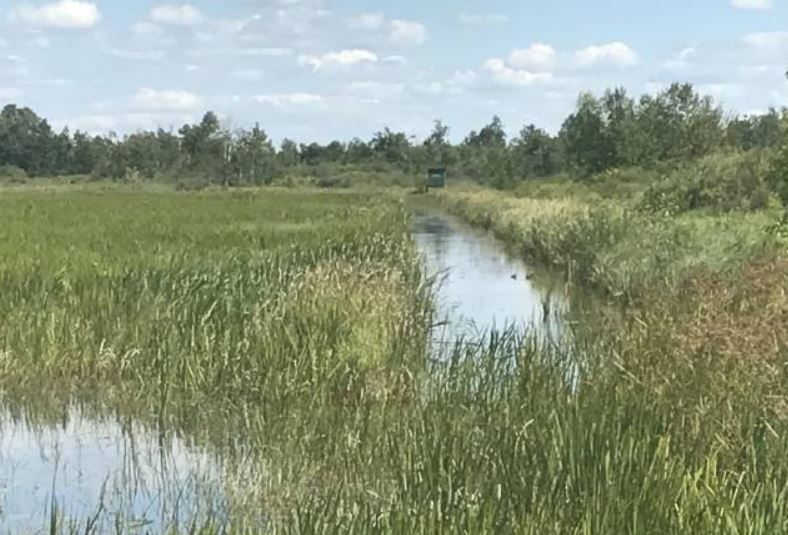Have You Considered the Farmable Wetlands Program?
Almost every farmer looks for ways to maximize the amount of land they have planted in row crops or hayfields, mostly because that means higher profits. But most of them also have some kind of marginal land that is a little too wet to plow or plant. Maybe a field along a swamp that you are tempted to plow, but it just always seems to be a sinkhole during the planting or harvest season. Even if you do get it planted, it generally doesn’t produce as well as other upland soils anyway. Have you ever considered the Farmable Wetlands Program, also called FWP, for your farmland? If you are not familiar with the program, here is a little description of how it works and how you might be able to use it for your property.
What is the Farmable Wetlands Program?
The FWP was created to restore previously farmed wetlands and wetland buffers to improve the native vegetation and water flow on properties. Participants in the farmable wetlands program must agree to restore the wetlands, establish plant cover (including submerged or emergent plants, or even trees), and not use the land for commercial purposes (such as row crop production). The Farm Service Agency (FSA) runs the program through the Conservation Reserve Program (CRP), and it is one of several USDA farm programs meant to help farmers with their land. While the CRP program provides an inventive to not plant erodible uplands (and instead keep it planted in native grasses and forbs), the wetland program encourages farmers not to plant lowland areas and instead let the wetland functions persist as they naturally would. Similar to a CRP program payment, landowners who participate in the farmable wetlands program receive an annual rental payment for the acres enrolled in the program. In addition, the FWP is an FSA cost share program to help offset the costs associated with establishing wetlands on their property – typically, up to 50% of the costs may be shared.
Why Consider the Farmable Wetlands Program?
If it’s not clear already, restoring farmed wetlands and buffers helps improve water quality, stop soil erosion, slow down stormwater flow, and it has the happy side effect of also enhancing wildlife habitat for several species (e.g., waterfowl, deer, turkeys, etc.). These are all very positive outcomes for your farm that will help it in the end. Additionally, the program is a good way to still earn some kind of passive income off marginal land that does not usually produce much anyway. Then you save on not having to till, plant, fertilize, spray, and harvest as well.

What Land is Eligible?
To be eligible for this program, however, there are a few requirements. The land must have been used for agricultural purposes for 3 out of the past 10 crop years. That means you could have had it planted in some kind of row crop, vegetable garden, or hay field to meet the requirement. You can apply year-round for the program, and contracts can last 10 to 15 years. You can apply to extend your contract at the end of it, but it is a competitive program with limited funding for the country and a maximum enrolled acreage.
How to Combine with Land Leasing
If creating additional wildlife habitat, enhancing your farm and the environment, and being paid to do so sounds like a winning plan to you, you should absolutely consider applying to the program. However, if you want to further sweeten the deal, here is how you can combine the farmable wetlands program with leasing hunting land to earn a double income on the same property. Waterfowl hunting leases are in high demand in parts of the country, and might be the perfect opportunity for you. Now if you want to hunt the land yourself, this approach might not appeal to you. But you can still reap the benefits of improving the habitat and having more wildlife to hunt on your property, and that’s worth the effort in itself.
As we mentioned before, restoring wetland functions to your property can increase the wildlife value and attraction for several wildlife species. The most obvious group of animals would include waterfowl species, such as ducks and geese. Leasing your land to hunters could be very lucrative if the following things are true about your property.
- You are located in an actual flyway to attract enough birds to make it worthwhile to hunt. If your property doesn’t hold waterfowl even after the wetland restoration projects, then you probably don’t have much to offer in a hunting lease anyway. But if your wetlands routinely attract ducks and geese, make sure to keep track of it and take pictures if possible to document for your lease listing.
- You have the right mix of habitats adjacent to the restored wetlands. The ideal habitat for ducks and geese in the fall during migration includes shallow water and native vegetation cover adjacent to food sources. Harvested grain (e.g., oats, milo, wheat, etc.), corn, and bean fields can all provide a lot of food for waterfowl, especially when they can use wetlands and waterways immediately next to the fields. Restoring the native vegetation and water sources through your farmable wetlands program will provide the cover they need.
How to Maximize the Two Approaches
So how should you combine these two approaches to maximize your success? Take time to chat with your FSA representative and make sure you restore an appropriate wetland type for your region. You want it to be naturally attractive for ducks. After restoring wetlands and leaving wetland buffer strips along them through the FWP, you could plant several rows of high quality waterfowl food plot species (e.g., milo, wheat, oats, corn) directly adjacent to the buffers and leave them standing. Assuming your property does attract ducks and geese to the restored wetlands, they should definitely hit the food sources nearby. You can then list your property as a waterfowl hunting lease at Base Camp Leasing. The little money you might lose in not planting and harvesting your typical row crop along the wetland buffers could be made up by leasing it out. To recap, you would be paid an annual rental payment for doing essentially nothing with your wetlands, and hunters would lease the small area of cropland adjacent to them to make up the difference.
How to Get Started
If all of the above interests you, it is time to get moving on it. Begin by researching USDA programs or even typing “USDA office near me” into your browser to start the conversation. You might be surprised at how easy the process can be, and it will really pay off for your farm in the long-term health of the soil. To get started leasing your property, reach out to us and we can take you through the whole process.
[av_promobox button=’yes’ label=’Handling Flooded Crop Fields’ link=’manually,https://huntingleases.basecampleasing.com/how-to-handle-crop-damage-by-excessive-rain-and-floods/ ‘ link_target=’_blank’ color=’theme-color’ custom_bg=’#444444′ custom_font=’#ffffff’ size=’large’ label_display=” icon_select=’no’ icon=’ue800′ font=’entypo-fontello’ box_color=” box_custom_font=’#ffffff’ box_custom_bg=’#444444′ box_custom_border=’#333333′ av_uid=’av-24263n’ custom_class=” admin_preview_bg=”]

[/av_promobox]
GET INFO ABOUT LEASING THE HUNTING RIGHTS TO YOUR PROPERTY
[av_sidebar widget_area=’SRM-CAPTCHA-FORM’ av_uid=’av-2q9txt’]


Leave A Comment